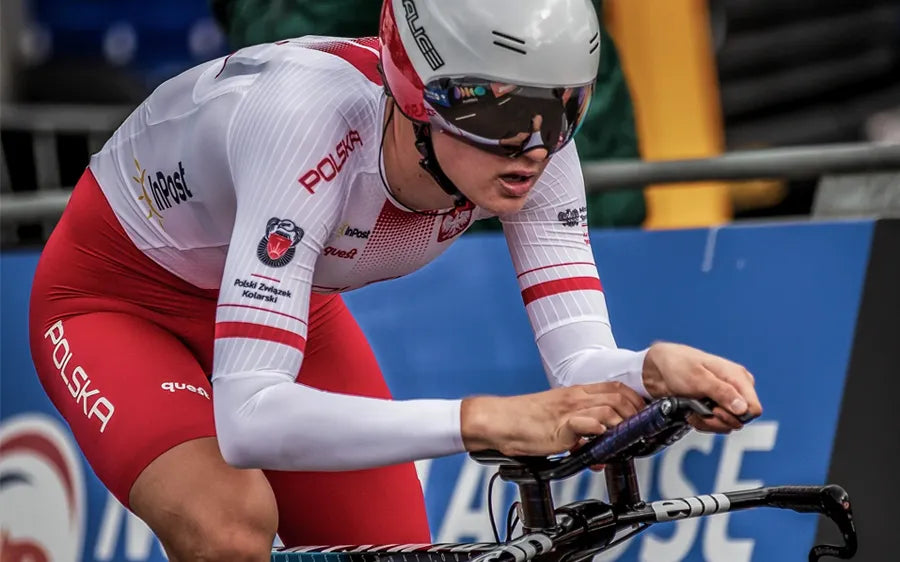With the likes of Lotte Kopecky, Demi Vollering, Mathieu van der Poel, Jonas Vingegaard, and many more, the modern days of cycling are a treat to watch. The fusion of physical endurance and mental resilience is what captured the hearts of countless individuals around the world.
Riding bikes is not only captivating as a spectator sport but also accessible to do yourself! Whether you’re looking to explore your neighborhood or chase every KOM around the neighborhood, cycling will have a positive influence on your physical and mental well-being (as long as you do not crash, we’re looking at you MvdP). Most serious cyclists choose specific races to show the world what they got and mark these specific dates in their calendars. Peaking at these races requires strategic planning of intense training blocks and recovery.
For the everyday athlete, it might be less important to peak at a specific race, but for those striving to enhance their performance, it is relevant to manage and analyze their progress. Tracking progress is relevant because:
- It shows what you worked for
- it shows if the training you did worked well
- it shows if the training you did needs to be adjusted
In cycling, measuring your progress helps in setting relevant, reachable goals, and breaking your own boundaries.
In a previous post, we have spoken about the exercise test you can perform with the Train.Red sensors. How-to take your cycling assessment to the next level with Train.Red. In this blog, we are going to look at the aerobic fitness an athlete has gained during a 6-week training program. We will show two ramp tests performed by the same athlete and explain how alteration in muscle deoxygenation can tell if aerobic fitness has improved.
The case study
In this case study we will take a look at the data from a recreational cyclist who has been cycling twice a week for the past two years. The athlete performed an initial ramp test, and concurrently with his weekly cycling routine, followed a six-week training program consisting of two weekly sessions of high-intensity interval training (HIIT). At the end of the six weeks, the athlete repeated the ramp test to assess the changes in his performance.

What is HIIT?
HIIT is a training method that can enhance endurance performance by improving oxygen utilization, optimizing mitochondrial function, and increasing the body’s ability to tolerate and clear lactate. It achieves this by training at high-intensity intervals, where the body relies mainly on anaerobic metabolism. These adaptations improve the muscle’s efficiency in utilizing anaerobic systems at higher intensities, while also providing aerobic benefits. The combination of both aerobic and anaerobic adaptations makes HIIT an effective approach for improving overall fitness and performance.
Training Protocol and Testing
The subject’s training regimen included two-week HIIT sessions: one short HIIT workout consisting of a one-minute series and one long HIIT workout consisting of a four-minute series. This balanced approach aims to improve cardiovascular fitness and is based on a meta-analysis by Wen et al. (2019).
The Incremental Ramp test protocol consisted of 5 minutes of warm-up followed by a power increment of 25W each minute until exhaustion. The test was followed by a free ride period of cool-down.

How can I identify improvement in muscle oxygen data?
Both Ramp tests are shown below. The improved performance was shown by increased test power output in the post-test.
The main observations at the muscle oxygen levels are:
- More efficiency at using oxygen
- Ramp Curve changes from a more parabolic profile to a more linear regression shape with an obvious earlier 2nd breakpoint
- Longer steady state in the SmO2 curve (2nd breakpoint)


What does this mean?
1. When you go all-out, your body first relies on the aerobic system for energy, which mainly works through oxygen. Then, when that’s not enough, the anaerobic system kicks in to provide extra energy. In this specific blog, the athlete hit the 2nd breakpoint earlier in the exercise test, which could mean that he is actually getting better at using the aerobic system, which makes the breakpoint more obvious than in the baseline test.
2. The athlete's breakpoint is indeed earlier, however, and he is able to hold the effort for a longer time. The shift from a more parabolic profile to a more linear regression shape with an obvious 2nd breakpoint suggests that the athlete's oxygen utilization efficiency has improved. As the exercise intensity increases during the Ramp test, the oxygen consumption by the muscles is better matched with the oxygen supply from the blood.
3. Longer Steady State in SmO2 Curve: It shows that the muscle is able to use oxygen efficiently at higher intensity levels, and therefore, there is a reduced reliance on oxygen as the intensity increases. This is evidenced by the longer period of stable SmO2 levels reached during the post-test. This suggests a shift to mainly anaerobic metabolism involving fast muscle fibers. This outcome was expected due to the HIIT program.
Conclusion
This ‘internal case study’ reinforces existing literature findings (Boone 2010; Spencer 2012) and offers valuable insights to cycling enthusiasts. It effectively demonstrates the benefit of a six-week high-intensity interval training (HIIT) program on muscle efficiency and oxygen utilization. The transformation in the shape of the SmO2 ramp curve illustrates the muscle’s enhanced ability to use oxygen more effectively as well as the enhanced ability to hold high-intensity efforts for a longer time by mainly relying on anaerobic metabolism. These outcomes provide valuable tools for cycling enthusiasts to self-assess, refine their training strategies, boost performance, and set informed performance goals.
Interested in Muscle Oxygen Sensors? You can check ours out here.
Wen, D., Utesch, T., Wu, J., Robertson, S., Liu, J., Hu, G., & Chen, H. (2019). Effects of different protocols of high intensity interval training for VO2max improvements in adults: A meta-analysis of randomised controlled trials. Journal of science and medicine in sport, 22(8), 941–947. https://doi.org/10.1016/j.jsams.2019.01.013
Spencer, M.D., Murias, J.M. & Paterson, D.H. Characterizing the profile of muscle deoxygenation during ramp incremental exercise in young men. Eur J Appl Physiol 112, 3349–3360 (2012). https://doi.org/10.1007/s00421-012-2323-y
Boone, J., Koppo, K., Barstow, T. J., & Bouckaert, J. (2010). Effect of exercise protocol on deoxy[Hb + Mb]: incremental step versus ramp exercise. Medicine and science in sports and exercise, 42(5), 935–942. https://doi.org/10.1249/MSS.0b013e3181c0ecea



